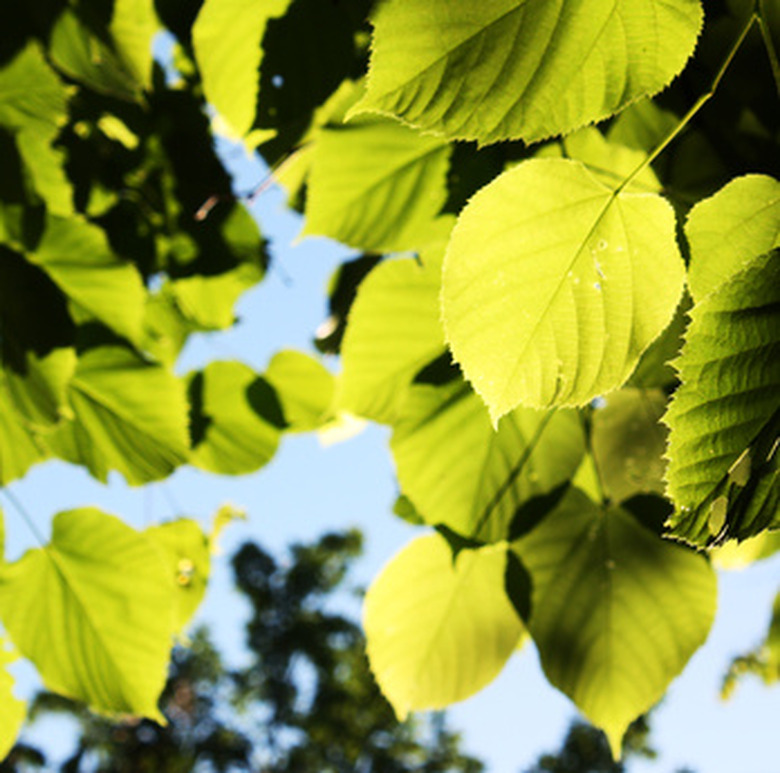Basswood Tree Facts
A handsome, large, deciduous tree with large, heart-shaped green leaves, basswood (Tilia Americana) is sometimes called the American linden. The early summer flowers are small but numerous, attracting honeybees with the fragrant sweet nectar. Growing best in nonacidic soils but still tolerating them, basswood prospers in U.S. Department of Agriculture winter hardiness zones 3 through 8.
Origins
Basswood is native to east-central North America. The native range extends from Canada's Manitoba and New Brunswick southward to the Ozarks and southern Appalachians in the United States. It grows in loam soils rich in nitrogen and comprises mixed hardwood forests across this region.
Features
The gray but thin bark on the straight trunk of basswood trees supports a well-branched structure of spreading, upright and slightly arching branches. Maturing with an oval shape at heights of 60 to 80 feet tall and 20 to 40 feet wide, it becomes an impressive tree. Often, suckering shoots sprout from the trunk or surface roots. Basswood leaves are made of glossy reddish brown twigs and are broadly oval-shaped, dark green above and glossy green underneath. The base of the leaf by the petiole stem looks like the uneven lobes of a heart. In late spring to midsummer, depending on the climate, the trees produce pendent clusters of fragrant, tiny greenish yellow flowers. Once pollinated by nectar-loving insects, the blossoms become small oval nutlets the size of a pea. They are hard and hairy. In autumn the leaves turn shades of yellow, gold and brown before dropping off.
- A handsome, large, deciduous tree with large, heart-shaped green leaves, basswood (Tilia Americana) is sometimes called the American linden.
- In late spring to midsummer, depending on the climate, the trees produce pendent clusters of fragrant, tiny greenish yellow flowers.
Wildlife Ecology
Basswoods provide good cover and habitat for a wide range of songbird species as well as tree-dwelling mammals. These critters also may eat the nutlets in fall and aid in their seed dispersal across the landscape. Tender twigs and buds of basswoods also provide food to browsing deer or rabbits. The thin bark of the tree is easily damaged by fire, limiting its presence in the western part of its range on the Midwestern prairies. Insect pests can proliferate on the basswood's foliage, including Japanese beetles, scale and leafminers. Honeybees savor the abundant nectar from the early summer flowers.
Uses
Basswoods are a traditional timber tree around the Great Lakes, providing a pale-colored soft wood for furniture, pulp and toys; it is particularly favored for hand-carving projects. Native Americans stripped young branches of their stringy inner bark fibers to weave and make rope. Baskets and floor mats also can be made from these fibers. The deep golden amber honey from the basswood has a stronger flavor and deeper color than that of clover honey. Basswood makes an impressive parkland shade tree but usually is not planted along streets because of its massive size and suckering roots. Smaller-leaved European linden species often are favored over basswood trees in ornamental landscapes.
- Basswoods provide good cover and habitat for a wide range of songbird species as well as tree-dwelling mammals.
- Tender twigs and buds of basswoods also provide food to browsing deer or rabbits.
Cultural Requirements
Grow basswood in regions with pronounced winter cold in soils that are deep, fertile and loamy. It grows best in neutral to alkaline soils (pH over 7.0) but is successful in acidic soil types, too. Tolerant of some shade from nearby trees, basswood develops its fullest shape when provided over eight hours of direct sunlight daily. Prune off suckering twigs that arise from the tree trunk base, as they appear to prevent a thicket in garden landscapes. Remove lower limbs when the tree is young so that there is ample clearance under branches for pedestrian or roadway traffic.
References
- United States Forest Service: Tilia Americana
- Illinois State Museum: Tilia Americana
- "Dirr's Hardy Trees and Shrubs"; Michael A. Dirr; 1997
